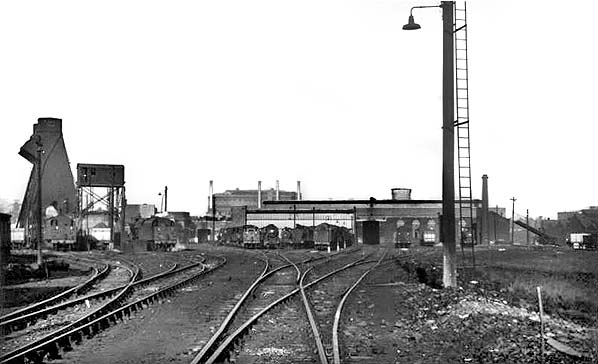
Looking north-west towards the three square roundhouses which made up Saltley shed on 7 January 1961. To the left is the ash handling plant and the large coaling stage.
Photo by D J Norton
The first shed was opened by the Midland Railway (MR) at Saltley in 1854, located north-west of their thriving goods depot at Lawley Street. The shed was of the roundhouse design with a central, 39ft turntable, and 24 roads which radiated from it. Although large in size the shed was inadequate for the ever-growing freight traffic both along the company’s main Derby to Bristol route and in the heavily industrialised West Midlands. The building was to undergo an extensive re-fit during 1864, but owing to the cramped nature of the site no further expansion could take place. The MR began to look for a new site which could accommodate their ever-increasing fleet of locomotives.
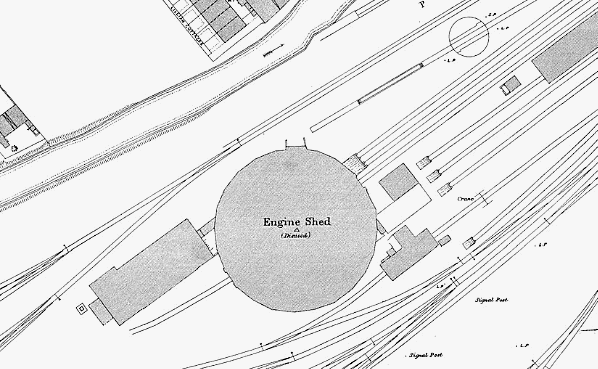 The original 1854 true roundhouse seen on an 1899 map, situated on the approaches to Lawley Street goods deopt and marked as disused.
The original 1854 true roundhouse seen on an 1899 map, situated on the approaches to Lawley Street goods deopt and marked as disused.
1868 saw the opening of a new shed, to the north-west of the original, still ideally placed on the main line and with plenty of land for expansion. A new roundhouse opened, although square in shape. Fitted with a 42ft diameter turntable with 24 roads radiating from it, the turntable would latterly be extended to 46ft and finally to a 55ft version. The original shed from 1854 was still in use at this time as a fitting shop as the new site was proving unable to accommodate the required number of locomotives. The situation of using two sheds on either side of the main line was to continue for several years. A new ‘square’ roundhouse was opened during 1876 alongside the 1868 version and was identical to the original. This then allowed the closure of the 1854 true roundhouse and the transfer of remaining equipment, although the building was not demolished until around 1901.
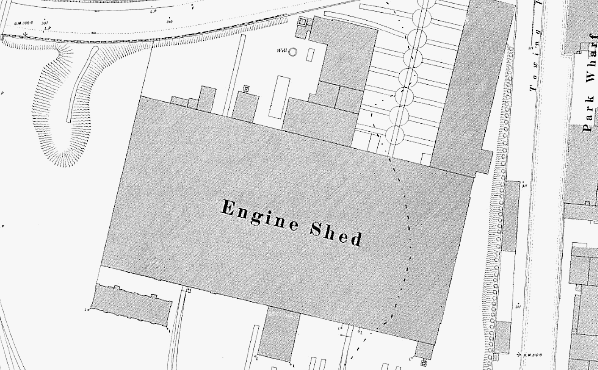
The new shed seen on the 1899 map following the erection of a further square
roundhouse to the left of the original.
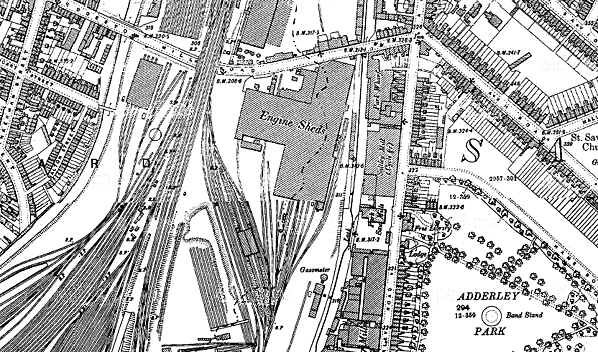 The building of the third square roundhouse is clearly evident on a 1905 map.
The building of the third square roundhouse is clearly evident on a 1905 map.
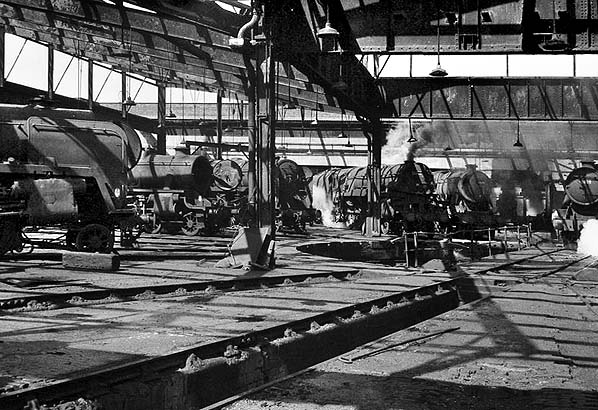
The interior of No3 shed seen in the late 1960's with, amongst others a Riddles 9F class 2-10-0 and ex-LMS Stanier desinged 8F's 48659 and 48629. The interior of the shed and the fabric of the building are showing signs of neglect.
Photo by Alan Pratt from his Seagull/21A Flickr photostream
The two roundhouses still could not accommodate all of the MR locomotives, and in 1900 a third square roundhouse was erected directly in front of the original No.1 shed. It was slightly larger in size with a 60ft turntable in the centre and 24 roads radiating from it the centre road, being used as a through road to reach the No.1 shed. By this point Saltley was at its peak and a very sizeable depot. Facilities at the depot included a smithy, stores, offices, staff amenity block, locker rooms, print shop and a large road-motor repair shop, to name but a few.
The shed was coded No.3 under the MR, and following the 1923 Grouping, the shed fell under the control of the London Midland & Scottish Railway (LMS) who coded it 21A in the re-organisation of 1935. By the end of the Second World War the shed was in need of refurbishment and plans to re-roof the No1 and No2 shed were drawn up in 1946. This work was delayed until after nationalisation in 1948 and No1 and No2 sheds were re-roofed using concrete which was in complete contrast to the steel and glass example in turn applied to No3 shed. From September 1963 British Railways (BR) gave the shed a code of 2E which it retained until closure. Following the Modernisation Plan of 1955 and the run-down of steam the shed would be closed and the vast majority of it demolished. It was not the end for Saltley, as BR would erect a Diesel Locomotive Inspection Point (LIP) and offices. This comprised a 3-road, steel-framed open-ended shed where diesel locomotives would be fuelled, watered and inspected. The new shed was closed and demolished in around 2000 although locomotives were still stabled there until 2006.
Today Saltley is still a signing on point for DB Schenker drivers and consists of several portakabins and a single road for the stabling of locomotives. The roundhouses and associated buildings were replaced with modern industrial units, and the site of the LIP is now marked with stacked track panels. Nothing remains apart from the original depot entrance from Duddeston Mill Road to point towards the once great depot that stood here.
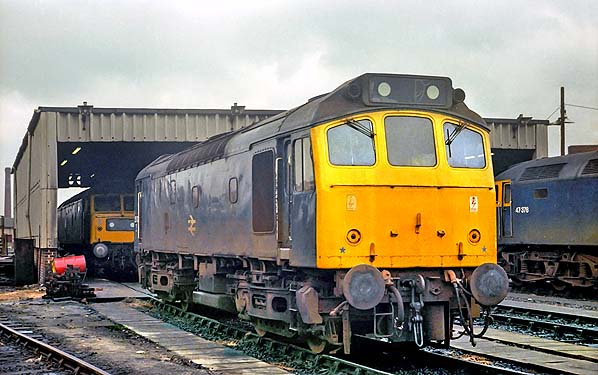
The 3 road Locomotive Inspection Point erected by BR seen in the spring of 1980 with Derby built Sulzer Type 2, later class 25 25132 at rest
Photo by Andy Hoare from his SilsonRoadrunner Flickr photostream.
Sources:
- London Midland and Scottish Railway Engine Sheds - Chris Hawkins
and George Reeve 1981
- The Directory of British Engine Sheds and Principal Servicing Points:1 Southern England, the Midlands, East Anglia and Wales-
Roger Griffiths and Paul Smith
1999
- Saltley Firing Days – Terry Essery 2010
|

